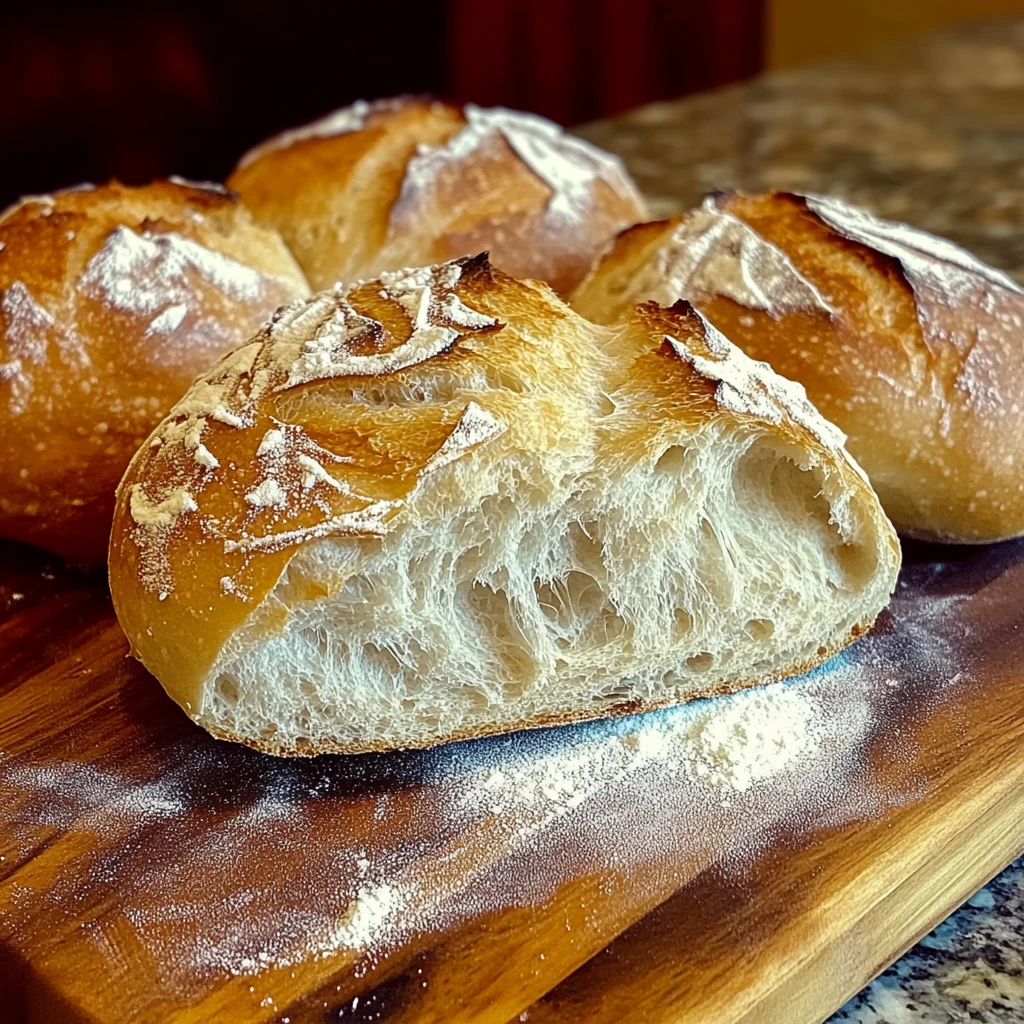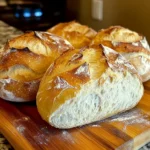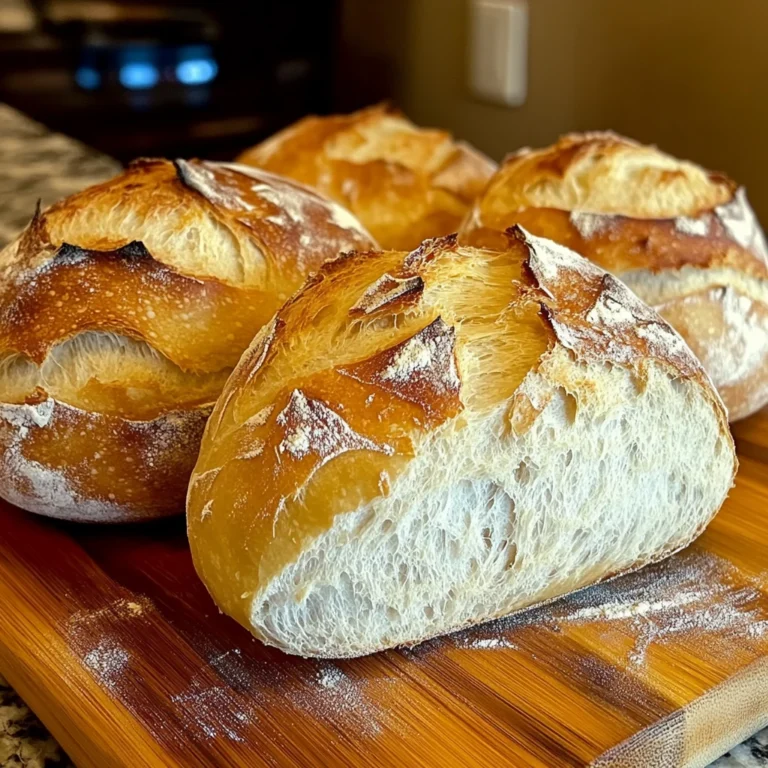Crusty Italian Bread is a beloved staple in Italian cuisine, cherished for its golden-brown exterior and soft, chewy interior. Whether you’re enjoying it alongside a hearty pasta dish, dunking it in a rich tomato sauce, or simply savoring it with a drizzle of high-quality olive oil, the allure of homemade Crusty Italian Bread is undeniable. In this comprehensive guide, we’ll dive into the secrets of baking this classic loaf, from understanding the key ingredients to mastering the techniques that will have you creating bakery-worthy Crusty Italian Bread right in your own kitchen.
Table of Contents
The Foundations of Crusty Italian Bread
Crusty Italian Bread has a long and storied history, with regional variations found throughout the Italian peninsula. This beloved loaf is a reflection of the country’s rich culinary traditions, where bread-making is considered an art form. The perfect Crusty Italian Bread should boast a golden-brown, crisp exterior that gives way to a soft, chewy interior, with a subtle hint of sweetness and a depth of flavor that can only be achieved through thoughtful baking.
In today’s fast-paced world, the art of homemade bread-making has become a cherished pursuit for many. The satisfaction of kneading the dough, watching it rise, and then pulling a freshly baked Crusty Italian Bread from the oven is a true delight. Not only does it fill your home with the tantalizing aroma of freshly baked bread, but it also allows you to create a culinary masterpiece that can be enjoyed with family and friends, or simply savored on your own.
Understanding the Ingredients for Crusty Italian Bread
The key to creating the perfect Crusty Italian Bread lies in the quality and balance of the ingredients. Let’s take a closer look at the essential components that come together to form this beloved loaf:
- All-Purpose Flour: The foundation of Crusty Italian Bread, all-purpose flour provides the structure and chewiness that characterize this classic loaf.
- Salt: A subtle but essential ingredient, salt enhances the overall flavor and helps to activate the yeast, resulting in a well-risen bread.
- Granulated Sugar: A small amount of sugar helps to feed the yeast, aiding in the fermentation process and contributing to the bread’s subtle sweetness.
- Warm Water: The perfect temperature for activating the yeast, warm water (around 110°F or 43°C) is crucial for achieving a light and airy crumb.
- Active Dry Yeast: The leavening agent responsible for giving Crusty Italian Bread its rise and distinctive texture.
- Cornmeal: Used to dust the baking surface, cornmeal helps to create a crisp, golden-brown crust on the bread.
Step-by-Step Guide to Baking Crusty Italian Bread
Ready to embark on your Crusty Italian Bread baking journey? Follow these simple steps to create a loaf that will impress your family and friends:
Activate the Yeast
In a large mixing bowl, combine the warm water, sugar, and active dry yeast. Stir gently and let the mixture sit for 5-10 minutes, or until it becomes frothy and bubbly, indicating that the yeast is active and ready to work its magic.</
Mix the Dough
Add the all-purpose flour and salt to the yeast mixture. Using a wooden spoon, stir the ingredients together until a rough dough begins to form.
Knead the Dough
Turn the dough out onto a lightly floured surface and knead it for 8-10 minutes, until it becomes smooth and elastic. This crucial step helps to develop the gluten, resulting in a chewy, well-structured bread.
First Rise
Place the kneaded dough in a lightly greased bowl, cover it with a damp cloth, and let it rise in a warm place for 1-1.5 hours, or until the dough has doubled in size.
Shape the Dough
Gently punch down the risen dough to release any trapped air bubbles. Shape the dough into a round or oval loaf and place it on a baking sheet dusted with cornmeal.
Second Rise
Cover the shaped dough with a cloth and let it rise for an additional 30-45 minutes, until it becomes puffy and airy.
Bake the Bread
Preheat your oven to 450°F (232°C) and place a shallow pan of water on the bottom rack to create steam, which will help develop the bread’s crisp crust. Make a few slashes on the top of the loaf with a sharp knife or razor blade. Bake the bread for 25-30 minutes, or until the crust is a deep golden-brown and the loaf sounds hollow when tapped.
Cool and Serve
Remove the Crusty Italian Bread from the oven and let it cool on a wire rack before slicing and serving. Enjoy the perfect balance of crunch and chew, and savor the delightful flavors that only a homemade loaf can provide.

Tips and Tricks for Perfect Crusty Italian Bread
To help you achieve bakery-quality Crusty Italian Bread at home, here are some tips and tricks to keep in mind:
- Kneading is Key: Spend the time to knead the dough thoroughly, as this helps develop the gluten and results in a chewy, well-structured loaf.
- Steam is Your Friend: Creating steam in the oven by placing a shallow pan of water on the bottom rack helps to develop the bread’s signature crisp crust.
- Don’t Skimp on Proof Time: Allowing the dough to rise fully, both during the first and second rises, is essential for achieving a light and airy crumb.
- Avoid Common Mistakes: Overproofing the dough, using too much or too little flour, and baking at the wrong temperature can all lead to dense, unappealing bread. Pay close attention to the recipe instructions.
- Store with Care: To maintain freshness, store your Crusty Italian Bread in a paper bag or wrapped in a clean, dry towel. Avoid plastic, which can make the crust soft.
Pairing and Serving Suggestions
Crusty Italian Bread is a versatile accompaniment to a wide range of Italian dishes. Serve it alongside hearty pasta dishes, such as spaghetti Bolognese or lasagna, to soak up the flavorful sauces. It also makes the perfect base for bruschetta, crostini, or classic Italian sandwiches like the iconic Panini. Don’t forget to drizzle the bread with high-quality extra-virgin olive oil or balsamic vinegar for a simple yet delectable treat.
Variations of Crusty Italian Bread
While the classic Crusty Italian Bread is a beloved staple, there are many ways to put your own spin on this traditional loaf. Consider incorporating fragrant herbs, such as rosemary or thyme, or adding olives, sundried tomatoes, or shredded cheese for a flavor-packed twist. For a sweeter take, you can experiment with Focaccia, a flatbread-style Italian bread that is often topped with herbs, garlic, and a drizzle of olive oil. And for those following a gluten-free diet, there are several excellent gluten-free Crusty Italian Bread recipes that can satisfy your cravings while catering to your dietary needs.
Frequently Asked Questions About Crusty Italian Bread
How can I achieve a thicker crust on my Crusty Italian Bread?
To achieve a thicker and crunchier crust on your Crusty Italian Bread, you can implement a few techniques during baking. First, ensure that your oven is adequately preheated to a high temperature (around 450°F or 232°C). Additionally, introduce steam into the oven by placing a shallow pan filled with hot water on the bottom rack while the bread bakes; this helps develop a crispy crust. Another method is to bake the bread longer, keeping an eye on the color to prevent burning. Lastly, consider using a baking stone or steel to retain heat better, which can also enhance crust formation.
Why is my Crusty Italian Bread too dense, and how can I fix it?
A dense loaf of Crusty Italian Bread can result from several factors, including inadequate kneading, insufficient rising time, or too much flour. To fix this, ensure you knead the dough until it is smooth and elastic, which typically takes about 8–10 minutes. Allow ample time for the dough to rise; it should double in size during the first rise. If you find your dough is too dry, try adding a little more water gradually until it reaches the right consistency. Lastly, always measure your flour accurately, as too much flour can lead to a denser loaf.
Can I use bread flour instead of all-purpose flour for Crusty Italian Bread?
Yes, you can use bread flour instead of all-purpose flour to make Crusty Italian Bread. Bread flour has a higher protein content, which can result in a chewier texture and improved structure. This is particularly beneficial for bread, as it helps develop gluten, leading to a better rise and texture. If you choose to use bread flour, you may need to adjust the water slightly, as it can absorb more moisture than all-purpose flour. Start with the same amount and adjust as needed based on the dough consistency.
How can I enhance the flavor of my Crusty Italian Bread?
Enhancing the flavor of your Crusty Italian Bread can be achieved in several ways. First, consider incorporating ingredients like herbs (such as rosemary or thyme), garlic, or even olives into the dough for added depth. You can also experiment with different types of yeast, such as sourdough starter, to introduce a tangy flavor. Another method is to let the dough undergo a longer fermentation, such as an overnight cold rise in the refrigerator, which develops more complex flavors. Finally, using a high-quality olive oil in the dough can also enrich the overall taste of your bread.
More Related Recipes You Might Enjoy
Embark on your Crusty Italian Bread baking journey today and experience the joy of creating a homemade loaf that will transport you straight to the heart of Italy. With a little practice and these expert tips, you’ll be turning out bakery-quality Crusty Italian Bread that will impress your friends, family, and your own taste buds. Happy baking!
Looking for more visual inspiration? Follow me on Pinterest, where I share new recipes, dinner tips, and behind-the-scenes kitchen moments every week. Buon appetito!
Print
Master the Art of Crusty Italian Bread with This Easy Recipe
- Total Time: 1 hour 50 minutes
- Yield: 1 loaf 1x
- Diet: Vegetarian
Description
Crusty Italian Bread is a beloved staple in Italian cuisine, cherished for its golden-brown exterior and soft, chewy interior. Whether you’re enjoying it alongside a hearty pasta dish, dunking it in a rich tomato sauce, or simply savoring it with a drizzle of high-quality olive oil, the allure of homemade Crusty Italian Bread is undeniable.
Ingredients
- 4 cup all-purpose flour
- 1 tablespoon salt
- 1 tablespoon granulated sugar
- 1 1/2 cup warm water
- 2 teaspoon active dry yeast
- cornmeal for dusting
Instructions
1. In a large mixing bowl, combine the warm water, sugar, and active dry yeast. Stir gently and let the mixture sit for 5-10 minutes, or until it becomes frothy and bubbly.
2. Add the all-purpose flour and salt to the yeast mixture. Using a wooden spoon, stir the ingredients together until a rough dough begins to form.
3. Turn the dough out onto a lightly floured surface and knead it for 8-10 minutes, until it becomes smooth and elastic.
4. Place the kneaded dough in a lightly greased bowl, cover it with a damp cloth, and let it rise in a warm place for 1-1.5 hours, or until the dough has doubled in size.
5. Gently punch down the risen dough to release any trapped air bubbles. Shape the dough into a round or oval loaf and place it on a baking sheet dusted with cornmeal.
6. Cover the shaped dough with a cloth and let it rise for an additional 30-45 minutes, until it becomes puffy and airy.
7. Preheat your oven to 450°F and place a shallow pan of water on the bottom rack to create steam. Make a few slashes on the top of the loaf with a sharp knife or razor blade. Bake the bread for 25-30 minutes, or until the crust is a deep golden-brown and the loaf sounds hollow when tapped.
8. Remove the Crusty Italian Bread from the oven and let it cool on a wire rack before slicing and serving.
Notes
Kneading is key to developing gluten.
Creating steam in the oven helps develop a crispy crust.
Allowing full proof time is essential for achieving a light crumb.
- Prep Time: 20 minutes
- Cook Time: 30 minutes
- Category: Bread
- Method: Baking
- Cuisine: Italian
Nutrition
- Serving Size: 1 slice
- Calories: 150
- Sugar: 1g
- Sodium: 400mg
- Fat: 1g
- Saturated Fat: 0g
- Unsaturated Fat: 0g
- Trans Fat: 0g
- Carbohydrates: 30g
- Fiber: 1g
- Protein: 4g
- Cholesterol: 0mg

